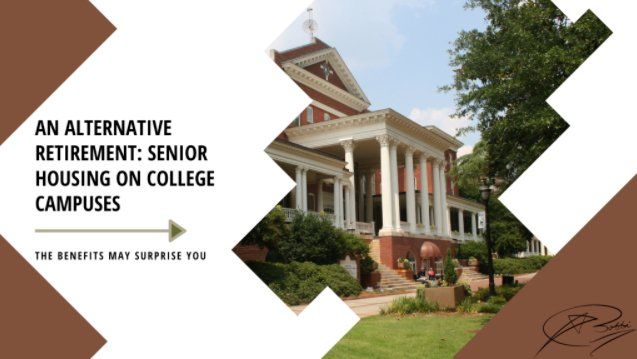Senior Spotlight: College-Based Senior Cohousing
A New Alternative for Retirement Living

2020 seems to be the year of the pivot, and many of us are opening our minds to doing things differently than we have done before. It’s no wonder that retirement community alternatives are part of the discussions, as older adults seek to improve their quality of life and sustain invaluable human connection. Perhaps that is why college-based senior cohousing (also known as university-based retirement communities or UBRC’s) has been making the headlines this summer and fall.
What is a UBRC?
University Business defines college-based senior cohousing as “a future emerging trend among the retirement options available that allow for successful aging in place.” UBRC’s are located on or within walking distance to college campuses and offer individual housing units for seniors (not dorms!). Unit types may be apartment-style living, small neighborhoods with townhomes, duplexes or single-family homes nearby higher education sites.
The Senior List reports that “many of the college- and university-based senior housing programs include a continuum of care, offering convenient access to providers and clinics for those who are more independent, as well as assisted living services for people managing chronic health conditions or who simply need more help.”
What are the benefits?
Living on a UBRC offers the best of both worlds with regards to quality of life. Most communities offer all of the traditional amenities of a senior living community, as well as the activities that students have access to such as school & athletic events, performing arts and cultural displays, mentoring and volunteer activities and even alumni offerings.
The biggest advantages are the option to enroll in college courses (many consider themselves lifelong learning institutes) and create intergenerational friendships – both key to quality of life and even possibly dementia delays. Furthermore, since most students don’t have cars on campus, UBRC’s offer a very walkable lifestyle and typically shuttle transportation to get around.
In addition, many campuses boast world-class medical centers, cutting edge research and teaching hospitals that offer a higher level of care. Access to clinical trials is even a possibility at some institutions.
How do UBRCs differ from assisted living and traditional senior communities?
The primary differences between college-based cohousing and assisted living or independent senior living is the diversity of activities and populations. In addition, not all senior living communities are walkable – but offer transport to and from dining, doctors and shopping instead.
If an older adult wishes to live mostly around others of the same generation, a UBRC may not be the best option. As a niche senior housing option, UBRC’s are designed for retirees seeking academic and cognitive stimulation, personal enrichment and multigenerational interactions on a regular basis.
Resources Used:
University Business: Why We Can’t Ignore College-Based Senior Cohousing
The Senior List: Life On A College Or University Campus – An Alternative Retirement Destination
All my best,
Bobbi Decker
DRE#00607999
Broker Associate
650.346.5352 cell
650.577.3127 efax
www.bobbidecker.com
NAR Instructor….“Designations Create Distinctions”
CIPS, SRS, ABR, CRS, SRES, GRI, CLHMS, REI, AHWD, RSPS, MSLG
Bobbi Decker & Associates fully supports the principles of the Fair Housing Act and the Equal Opportunity Act. For more information, please visit: http://portal.hud.gov/












